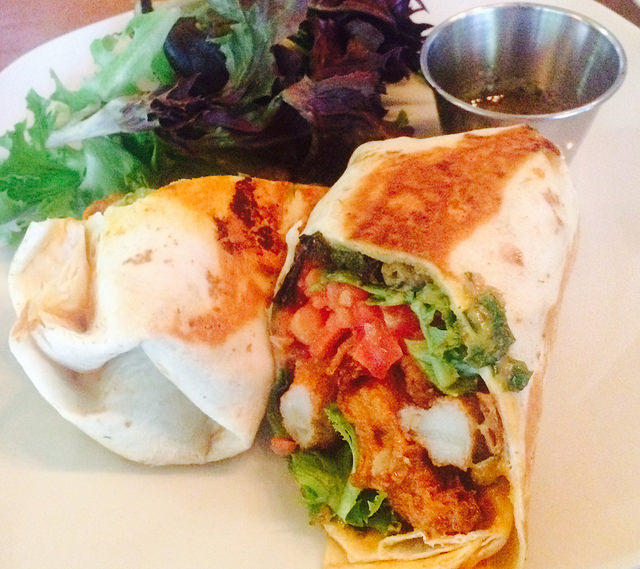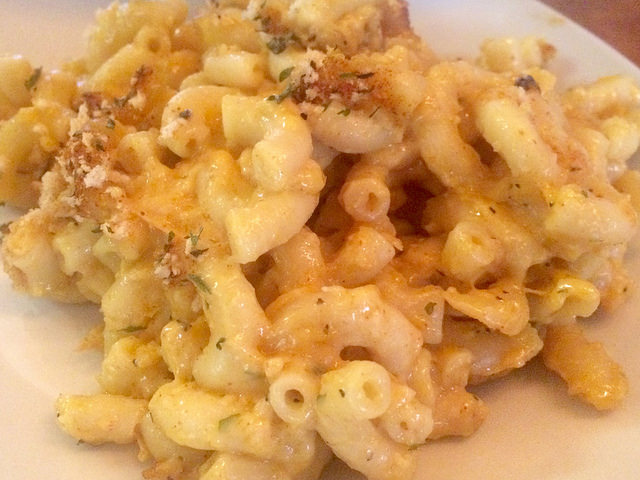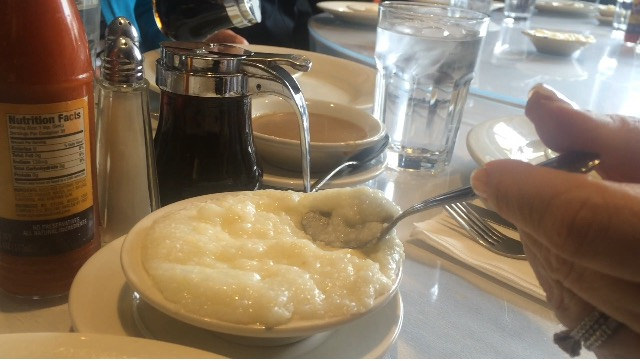
By Natasha Abellard
About 30 minutes after opening the restaurant doors, customers are already seated and placing orders. The Lemon Crusted “Chicken” Nuggets is a favorite, crispy golden brown on the outside with rich soy filling. Other menu options include their Po’ Boy, which comes with an option of fried soy shrimp or burdock root crawfish.
Seasoned Vegan is one of the latest restaurants contributing to Harlem’s rapidly changing food culture. Started by Brenda Beener in 2014, the restaurant serves gourmet and organic vegan cuisine.

Seasoned Vegan’s Macaroni & Cheese, is made using all vegan cheese. Photo by Natasha Abellard
Beener, who has been vegan for nine years, said that her family removed red meat from their diets, when her husband decided to try a 21-day vegan challenge. Once the challenge was over, he decided to stick with his vegan lifestyle. The change influenced the family’s eating habits and of course Beener’s cooking.
“I had to learn how to prepare food that my husband would eat but that my children would also enjoy,” she said. “I got cookbooks. None of them worked for me. I just decided that I was going to cook the way I cooked. I was just going to eliminate meat. So that’s what I did, I eliminated all animal products from my food.”
Her son, Aaron Beener, the restaurant’s general manager, believes that Harlem’s health disparities play a huge role in how Seasoned Vegan fits into the neighborhood’s changing food dynamics.
The 2015 New York City Department of Health statistics show that residents in Central Harlem are three times more likely to be obese and suffer from health issues, like diabetes, in comparison to residents in the downtown Manhattan neighborhood, Stuyvesant Town. The statistics also show that East Harlem residents are far less likely exercise and eat recommended daily servings of fruits and vegetables.
“People understand the health woes that we face in our community,” Beener said. “Every single one of us has somebody with diabetes in their family. At least one or multiple [people] probably. We might know somebody who passed away from it,” he said.
The neighborhood is known for their enormous soul food options. Traditional soul food is an African American cuisine that typically consists of fried chicken, macaroni and cheese, collard greens, yams, and more.
But the high calories and fat along with the increasing demands for healthier options in light of gentrification has caused a decline in demand. Higher rents have also forced out many of the older soul food restaurants. Harlem is now making way for more health conscious restaurants and grocery stores.
Jacqueline Orange, the founder of Taste Harlem Food & Cultural Tours, has witnessed the decline of soul food in Harlem over the years. So many of Harlem’s unique restaurants and boutiques have disappeared that Orange said she had to “create the vision of what was there for them (tourists) to see.”
During her food and cultural walking tour, Orange takes eager participants, some from as far away as Australia, to various restaurants in the Central Harlem area. In between her stops, she provides historical and cultural informational at various landmarks. Her first stop is always at Sylvia’s, one of the few soul food restaurants that have been able to survive Harlem’s gentrification.

A highlight On the Taste Harlem Food & Cultural Tours is eating grits at the legendary Sylvia’s Restaurant. Photo by Natasha Abellard
But for the Harlem resident and tour guide, the changes aren’t all bad. Orange believes that the increase in food accessibility is one positive effect of gentrification that older residents who can still afford to live in the neighborhood will enjoy.
“When I first moved here [in 2002], there was very limited amount of food options in Harlem. We had places to go, but not like now,” she said.
One of Orange’s stops includes the Best Market on Frederick Douglas Boulevard. The chain supermarket, which focuses on fresh goods and produce, is an example of the emerging food culture.
Orange explained to her group that due to lack of larger grocery stores, most lower income Harlem residents resort to food shopping at local bodegas (mini markets), contributing to poor diets and adding to the neighborhood’s health disparities. In Harlem, you can find as many as three to four bodegas on one block.
“In communities that are food deserts, you also see a lot of health issues. And having a really good grocery store is really important to a healthy community,” she said.
Best Market isn’t the only chain that will be serving the Harlem community. A new Whole Foods is also coming to Harlem and expected to open by end of 2016 on the corner of 125thStreet and Lenox Avenue.
The chains are coming uptown because of the support of the Upper Manhattan Empowerment Zone. The organization provides tax incentives, grants, and loans to businesses like Best Market that are interested in developing in underserved areas like Harlem.